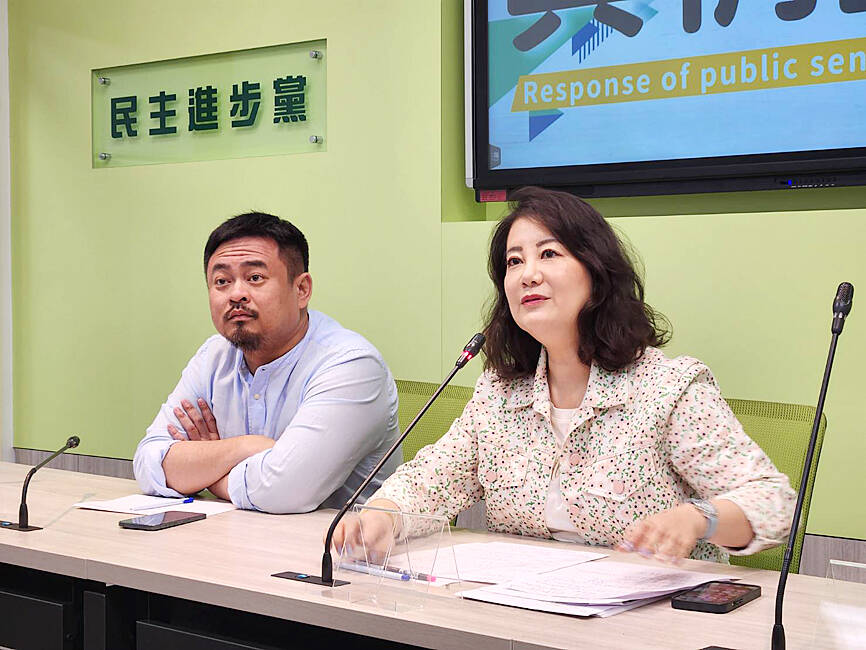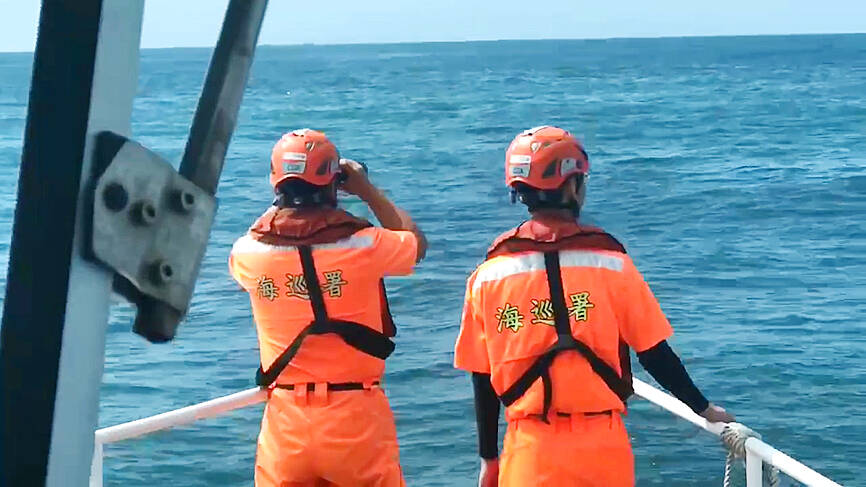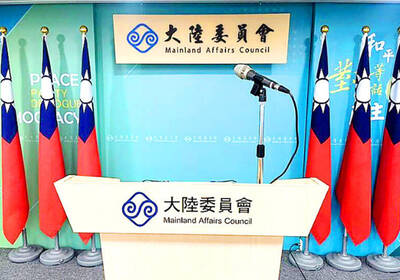The Democratic Progressive Party (DPP) caucus yesterday blasted Beijing after three Chinese vessels crossed the median line while Taiwan’s Coast Guard Administration (CGA) was helping with search-and-rescue efforts for Chinese fishers.
The Chinese fishing boat Min Long Yu 60877 on Saturday sank in waters off Kinmen’s Dongding Island (東碇島), with three of its crew members missing.
The CGA at about 4am on Saturday received a report saying that the Chinese fishing boat sank after colliding with an unidentified vessel 6.6 nautical miles (12.2km) east of Dongding and 9 nautical miles off the prohibited waters of Taiwan proper.

Photo: Hsieh Chun-lin, Taipei Times
Four crew members were rescued, but one of them passed away despite emergency treatment, and three remain missing.
While Taiwan dispatched personnel from the CGA and the armed forces to support the search-and-rescue operations, China’s Fujian Maritime Safety Administration and Donghai Rescue Bureau performed “a patrol and law enforcement operation in the Taiwan Strait from Saturday to Sunday,” China’s Xinhua news agency reported on Sunday.
The operation involved “three public service ships” and “lasted 30.5 hours,” covering “a total distance of 413 nautical miles,” it said.

Photo courtesy of the Coast Guard Administration
However, the CGA yesterday said that the three Chinese ships crossed the Taiwan Strait’s median line for 3.2 nautical miles (5.9km) before they turned around and sailed toward China.
Taiwan actively helped in the search for the Chinese fishers in the spirit of humanitarianism and mutual assistance even though it did not involve Taiwanese vessels and it was beyond Taiwanese waters, but its “good deed was punished” by China, DPP caucus secretary-general Rosalia Wu (吳思瑤) told a news conference yesterday.
China should control itself instead of using accidents to conduct “gray zone” activities to undermine Taiwan’s jurisdiction, DPP caucus deputy secretary-general Hung Sun-han (洪申翰) said.
Separately, CGA officials said they are increasing efforts to prevent Chinese fishing boats from operating across borders, adding that only sporadic violations have been reported so far.
As of noon on Sunday, only the outlying Matsu and Kinmen islands have reported a few cross-border Chinese fishing activities, the CGA’s Kinmen-Matsu-Penghu Branch said in a press release.
All illegal fishing vessels have been expelled, the CGA said, adding that there were no mass-scale contraventions, despite public concerns after China’s three-and-a-half-month fishing moratorium concluded on Friday.
However, the CGA said it had deployed one ship, 19 boats, 29 vehicles, 74 motorcycles and 301 personnel over the past two days in response to potential offenses.
The CGA also dismissed earlier media reports saying that Chinese fishing boats were using fake automatic identification systems (AIS) to appear as Taiwanese vessels.
Citing a marine patrol operation on Saturday afternoon, the CGA reported identifying about 20 Chinese fishing boats approximately 20 nautical miles outside the restricted waters around Penghu County, where no Taiwanese vessels or related AIS signals were detected.
In other developments, Xiamen University’s Cross-Strait Institute of Urban Planning on Aug. 5 said in a now-deleted online post that Beijing should be ready to “take over” Taiwan, as US former president and Republican presidential candidate Donald Trump is very likely to return to the White House and would accelerate cross-strait “reunification.”
Commenting on the matter, Wu yesterday said that Taiwan cannot be taken over by any party, and that Taiwan and China are not subordinate to each other.
“We have a democratically elected president of our own, and we can be protected only by ourselves,” she said.
Hung said that China has never ceased its statements threatening to take Taiwan by force, which have only resulted in fomenting a deep distrust of Beijing in the international community.
China should prioritize addressing domestic economic problems and not use external issues to cover its inability to manage internal affairs and the public’s disappointment, he said.
Taiwan’s future can only be decided by the 24 million people in Taiwan, Hung said, adding that “the statement made by Xiamen University’s researchers was delusional.”
Additional reporting by CNA

‘DANGEROUS GAME’: Legislative Yuan budget cuts have already become a point of discussion for Democrats and Republicans in Washington, Elbridge Colby said Taiwan’s fall to China “would be a disaster for American interests” and Taipei must raise defense spending to deter Beijing, US President Donald Trump’s pick to lead Pentagon policy, Elbridge Colby, said on Tuesday during his US Senate confirmation hearing. The nominee for US undersecretary of defense for policy told the Armed Services Committee that Washington needs to motivate Taiwan to avoid a conflict with China and that he is “profoundly disturbed” about its perceived reluctance to raise defense spending closer to 10 percent of GDP. Colby, a China hawk who also served in the Pentagon in Trump’s first team,

SEPARATE: The MAC rebutted Beijing’s claim that Taiwan is China’s province, asserting that UN Resolution 2758 neither mentions Taiwan nor grants the PRC authority over it The “status quo” of democratic Taiwan and autocratic China not belonging to each other has long been recognized by the international community, the Mainland Affairs Council (MAC) said yesterday in its rebuttal of Beijing’s claim that Taiwan can only be represented in the UN as “Taiwan, Province of China.” Chinese Minister of Foreign Affairs Wang Yi (王毅) yesterday at a news conference of the third session at the 14th National People’s Congress said that Taiwan can only be referred to as “Taiwan, Province of China” at the UN. Taiwan is an inseparable part of Chinese territory, which is not only history but

CROSSED A LINE: While entertainers working in China have made pro-China statements before, this time it seriously affected the nation’s security and interests, a source said The Mainland Affairs Council (MAC) late on Saturday night condemned the comments of Taiwanese entertainers who reposted Chinese statements denigrating Taiwan’s sovereignty. The nation’s cross-strait affairs authority issued the statement after several Taiwanese entertainers, including Patty Hou (侯佩岑), Ouyang Nana (歐陽娜娜) and Michelle Chen (陳妍希), on Friday and Saturday shared on their respective Sina Weibo (微博) accounts a post by state broadcaster China Central Television. The post showed an image of a map of Taiwan along with the five stars of the Chinese flag, and the message: “Taiwan is never a country. It never was and never will be.” The post followed remarks

INVESTMENT WATCH: The US activity would not affect the firm’s investment in Taiwan, where 11 production lines would likely be completed this year, C.C. Wei said Investments by Taiwan Semiconductor Manufacturing Co (TSMC, 台積電) in the US should not be a cause for concern, but rather seen as the moment that the company and Taiwan stepped into the global spotlight, President William Lai (賴清德) told a news conference at the Presidential Office in Taipei yesterday alongside TSMC chairman and chief executive officer C.C. Wei (魏哲家). Wei and US President Donald Trump in Washington on Monday announced plans to invest US$100 billion in the US to build three advanced foundries, two packaging plants, and a research and development center, after Trump threatened to slap tariffs on chips made